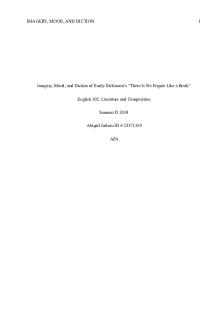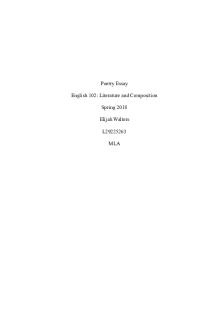Poetry Analysis Essay - Grade: A+ PDF

| Title | Poetry Analysis Essay - Grade: A+ |
|---|---|
| Author | Sandra Cross |
| Course | English Composition |
| Institution | University of Alabama |
| Pages | 5 |
| File Size | 73.2 KB |
| File Type | |
| Total Downloads | 89 |
| Total Views | 159 |
Summary
Taught by Mr. Beall. English Comp 102 Mandatory Poetry Essay on "The Mother" by Gwendolyn Brooks.
Title of the essay is included in the document- is it called: The Poetry Analysis of "The Mother" by Gwendolyn Brooks....
Description
Cross 1 Mr. Beall English Composition 102 12 June 2016 Poetry Analysis Essay Draft: The Mother by Gwendolyn Brooks
Poetry is an underestimated way for someone to express their feelings and emotions towards a subject. What is also so wonderful about poetry is that everyone perceives it differently. It allows for creativity to flow in whichever directions chosen in order to transfer ideas from one mind to another. This is exactly what Gwendolyn Brooks does in her poem “The Mother”. She allows her creativity to flow in order to give her readers a true emotional connection to her work. Brooks uses several forms of literary devices such as imagery, mood, and tone to convey themes of grief and mourning to her readers. Because of her style in writing her poetry, the readers are able to feel as if they were in the place of the narrator from her poem “The Mother”. Brooks utilizes the effects of imagery to help her convey themes of grief and mourning in her work. For example, she writes “The small damp pulps, with little or with no hair” (line 3). The narrator within this poem is vividly imagining what her unborn children would look like, had they been born upon this earth. Brooks’ incorporation of this imagery allows for the themes of grievance and mourning to be portrayed in a unique way. An alternative example of imagery within “The Mother” is when Brooks writes “I have heard the voices of the wind the voices of my dim killed children…” (line 11). The way Brooks writes this imagery into her poem, gives her readers a sense of reality. One can imagine the way the mother in this poem is narrating the text; in complete agony and grief. The ability to imagine the text is what makes imagery
Cross 2 significant, especially when trying to convey a theme to a group of readers. The final example of imagery within Brooks’ work is when she writes “My dim dears at the breasts they could never suck” (line 13). By including this line within her text, Brooks is able to portray an emotional connection between a mother and her unborn children. By doing so, she is able to truly give the effect that the narrator within her poem is mourning her lost children. Brook’s successfully uses imagery to have her readers be able to experience the themes of grief and mourning within her work. As well as using imagery within her work to convey themes of grief and mourning, Brooks also takes advantage of creating various moods through her diction and syntax. A regretful mood can be sensed when Brooks writes “Believe that even in my deliberateness, I was not deliberate” (line 21). The way Brooks structures this line, the readers have some thinking to do and a few assumptions to make about the true meaning behind this text. There are many ways for this line to be interpreted but one thing is for sure; it is in the way it is read that a regretful mood is sensed. Least but not last, Brook’s portrays a mood of heartbreak within her poem when she writes “You will never wind up the sucking-thumb/or scuttle off ghosts that come” (lines 78). Brooks is able to convey the themes of mourning and grief within this line because she uses personal references to having children to set the tone. Heartbreak is a relevant tone seeing that the narrator is in a stage of heartbreak because of her children being aborted. Lastly, an example of Brooks using mood to convey themes of grief and mourning, is when she writes “Though why should I whine/Whine that the crime was other than mine?”. Brooks’ uses this line to place a cold or shallow mood over this part of her text. In doing so, she is able to convey the themes of grief and mourning through her story. Brooks wonderfully weaves different mods into her work for the readers themselves to experience.
Cross 3 Ultimately, Brooks administers tone into her poem to give her readers a more efficient way of perceiving her themes of grief and mourning. A prime example of tone within Brooks’ work is when she writes the first two lines of her poem: “Abortions will not let you forget/ You remember the children you got that you did not get” (lines 1-2). In these two lines, Brooks incorporates a tone of remorse. The narrator will never forget what she has done, and is in turn teaching this to other potential mothers, that one can never forget. This tone of remorse within her first two lines easily portrays a sense of the themes grief and mourning. Another example of tone within “The Mother” is stated in lines 29 and 30: “You were born, you had body, you died/It is just you never giggled or planned or cried”. Brooks is able to convey her themes of grieving and mourning within her poem by placing a tone of reality into her piece. The narrator is portrayed as being realistic towards herself about what she has done. Lastly, themes of grief and mourning are displayed through tones of affection and nostalgia when Brooks writes “Believe me, I loved you all/Believe me, I knew you, though faintly, and I loved, I loved you. /All” (lines 31-33). Brooks incorporates these tones of affection and nostalgia into her work to, again, display to the readers the themes of grieving and mourning. The tones were able to help portray the affection and motherly instinct the narrator still has though she has no born children. Hand in hand, Brooks, once again, has successfully woven in a literary device in her work to convey themes of grief and mourning to her readers. She successfully portrays the themes of mourning and grief throughout her poem “The Mother”. Her use of imagery, moods, and tones assists her to expound upon her themes of grief and mourning through the way she writes her poem. These literary devices displayed within Brooks’ poem make it possible for readers to gain a sense of understanding and knowledge of the feelings that one can perceive from a literary work.
Cross 4
Cross 5
Works Cited
Roberts and Zweig, “Literature: An Introduction to Reading and Writing,” All Chapters on Poetry....
Similar Free PDFs

Poetry Essay - Grade: A+
- 5 Pages

Essay Poetry - Grade: A
- 3 Pages

Poetry Essay - Grade: 80%
- 6 Pages

Poetry Essay - Grade: B
- 5 Pages

Poetry Analysis Essay Examples
- 7 Pages

Makeup analysis essay - Grade: A
- 8 Pages

Poem analysis essay - Grade: a
- 2 Pages

Job analysis essay - Grade: A
- 6 Pages

Visual Analysis Essay - Grade: A
- 4 Pages

Poetry Paper 2 - Grade: a
- 7 Pages

Analysis Essay - Grade: 97
- 3 Pages

Analysis essay - Grade: B+
- 3 Pages
Popular Institutions
- Tinajero National High School - Annex
- Politeknik Caltex Riau
- Yokohama City University
- SGT University
- University of Al-Qadisiyah
- Divine Word College of Vigan
- Techniek College Rotterdam
- Universidade de Santiago
- Universiti Teknologi MARA Cawangan Johor Kampus Pasir Gudang
- Poltekkes Kemenkes Yogyakarta
- Baguio City National High School
- Colegio san marcos
- preparatoria uno
- Centro de Bachillerato Tecnológico Industrial y de Servicios No. 107
- Dalian Maritime University
- Quang Trung Secondary School
- Colegio Tecnológico en Informática
- Corporación Regional de Educación Superior
- Grupo CEDVA
- Dar Al Uloom University
- Centro de Estudios Preuniversitarios de la Universidad Nacional de Ingeniería
- 上智大学
- Aakash International School, Nuna Majara
- San Felipe Neri Catholic School
- Kang Chiao International School - New Taipei City
- Misamis Occidental National High School
- Institución Educativa Escuela Normal Juan Ladrilleros
- Kolehiyo ng Pantukan
- Batanes State College
- Instituto Continental
- Sekolah Menengah Kejuruan Kesehatan Kaltara (Tarakan)
- Colegio de La Inmaculada Concepcion - Cebu



